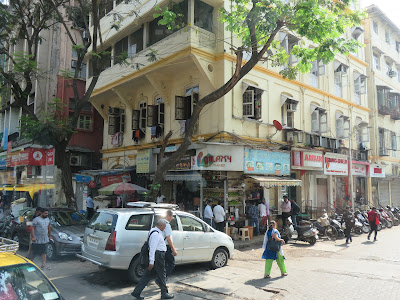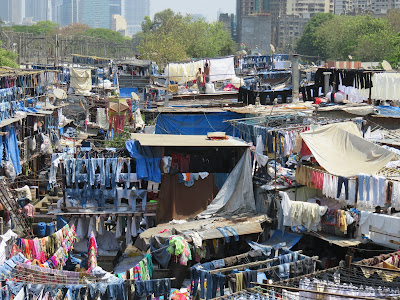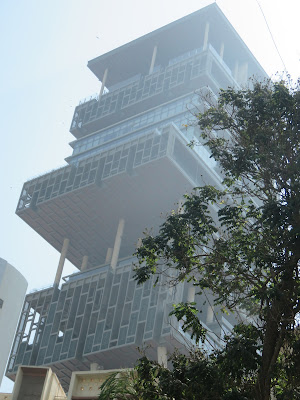Cruise Day 7 – Cochin
We were most impressed with the tropical vegetation and river
fronted homes and apartments as we sailed into Cochin. The Harbour is actually
a lake, not open ocean and the water becomes brackish as the sea and fresh water
meet.
We had been warned about the complicated immigration process
so we were pleasantly surprised when our landing cards were simply stamped and
we moved on to our bus. After driving down Mahatma Gandhi Road, which is packed
full of court and magistrate buildings, colleges and schools, we stopped at Lord
Shiva’s Temple, a rather plain looking building next to a more ornate temple
complete with multi-coloured timber carvings. Our guide, Sri, has a Masters in
History and proudly pointed out the college from which he gained his
qualification.
Next we drove to Dhobi Khana, a commercial laundry that was introduced
in 1897 by the Dutch for their servicemen and later for local people and
businesses. Dirty laundry is picked up and delivered to Dhobi Khana, where it
is washed early in the morning and hung out to dry, not with pegs but using
twisted ropes. It is then collected and taken to the ironing room, pressed,
folded and returned to the owner. The service is cheap and is ideal for people
who don’t have their own laundries. One man, who carried washing and folded and
ironed, has been working at the laundry for 41 years.
We arrived at the beach and wandered past market stalls where
young mothers in beautiful saris and with babes in arms attempted to sell us bracelets
and scarves. There we viewed the Chinese Fishing Nets, impressive in their size
and structure. On to St Francis Church, the first European church built in
India, in the 16th Century. It was converted to protestant by the
Dutch in 1663 and for fourteen years was the site of Vasco da Gama’s grave
before his body was removed back to Portugal. After a refreshment break at
David Hall art gallery, housed in yet another 16th Century building,
we visited a women’s co-operative that sells spices, silks, jewellery, pashmina
and souvenirs.
Cruise Day 9 - Goa
Temple
On the street
Newer high rises
Older high rises
Ironing at Dhobi Khana - note the iron
giant Chinese fishing nets
Rubbish everywhere - this is on the beach
Cruise Day 9 - Goa
In the early morning we boarded a very old bus for our day
in Goa. Fortunately the aircon was very effective, because we needed it. Our
first stop was the Aguada Fort which was built by the Portuguese in 1612 to
thwart invasions by the Dutch and French. Back then it had 79 cannons and is an
impressive structure which includes its own lighthouse. The second fort was the
Reis Margos, built by the local Indians with 39 cannons installed, some of
which remain. Here there is a museum that displays Goa’s extensive military history
and the views from both forts are spectacular.
Panjim is Goa’s capital and we first wandered through the
city streets before spending time at the huge local market with fruit and
vegetables, flowers and everything from mobile phones to kitchenware. An Indian
buffet lunch was served to us at a traditional Portuguese house on the river
where a trio of local entertainers entertained us with well-known songs.
Our guide for the day, Joachim, has a Bachelor of Commerce
but has been a freelance guide for four years. Many Indians have multiple jobs
and change them frequently, but unemployment remains low. Joachim was fun and informative
and, given the apparent total lack of road rules in Goa, even left the bus at
times to remove obstacles from the road and to direct traffic. His repartee
with the driver in Indian, and several near misses on the roads only added to
our entertainment. After telling several jokes on the way back he said he had
now shown us the coastline but asked what was in the middle of Goa? Inspiration
struck and I said, ‘an O’. He looked shocked that anyone would know the answer
but congratulated me!
In the ceiling inside the entrance to the fort are holes through which boiling oil was poured over the enemy as they tried to enter!
The church next door to the fort
Goa city
Fresh fruit and vegetable market
Entertainment at lunch at the Portuguese house
Mumbai is the financial and commercial capital of India, and
hosts a plethora of beautiful historic stone buildings. We began our bus tour with
a drive through the city, our female guide pointing out important buildings like
the General Post Office, the enormous Victoria Railway Terminus, the Municipal
Corporation and the Bombay Gymkhana. Land is at a premium in Mumbai and the
Gymkhana holds the city’s only golf course.
The population of Mumbai is 18 million which in reality, our
guide said, is more like 23 million. The people are all religious but the majority
is Hindu, followed by Moslem and then Christian and Buddhist, etc. Sadly, 60%
of the people live in slums as millions arrive from all over India seeking work
in what she describes as a ‘developing city’. As a result, the infrastructure
cannot fully support the population; buildings are in disrepair, traffic is
horrendous and pollution is inescapable. For two years now the city has been
building an underground railway system which our guide believes will relieve
some of the congestion.
As in other Indian cities, the poor live alongside the rich
and the most expensive house in the world is located here - built at a cost of over $2 billion. It is an enormous
high-rise cantilevered building, architecturally designed by an American
company towering above the smaller, crumbling apartment buildings that dot
the city’s landscape. Mumbai’s tallest residential towers have 64 floors!
The Dhoby Ghat laundry is an enormous enterprise set on
acres of land in the middle of the city. It is over 140 years old and employs
5-6,000 people, mostly from outside of Mumbai, who launder millions of items of
clothing each week. On the way there we stopped in at the Mani Bhavan, now a museum,
where Gandhi lived from 1917-1934 and where he launched civil disobedience in
an effort to claim independence for India. He is indeed revered here.
Our final destination was the Chhatrapati Shivaji Maharaj
Vastu Sandrahalaya - or Prince of Wales Museum. An impressive historic
building, it contains vast halls of amazing displays including sculpture,
natural history, European paintings, a Chinese and Japanese gallery and even a
children’s museum. We had 35 minutes, I could easily have spent a few hours. On
the way back to the ship we passed by The Gateway of India, a famous landmark
used in days gone by as the customs entrance to Mumbai from passengers of all
types of ships.
And so we leave the heat of India bound for the heat of the
Middle East!
One of many colonial buildings in Mumbai
City street
Municipal Building
Railway station
At Gandhi's House
Dhoby Ghat Laundry
Most expensive 'house' in the world - $2 billion
Inside the Prince of Wales Museum
The Prince of Wales Museum building and grounds
Mumbai Harbour
The Gateway of India
The 'pigeon' tree














































No comments:
Post a Comment